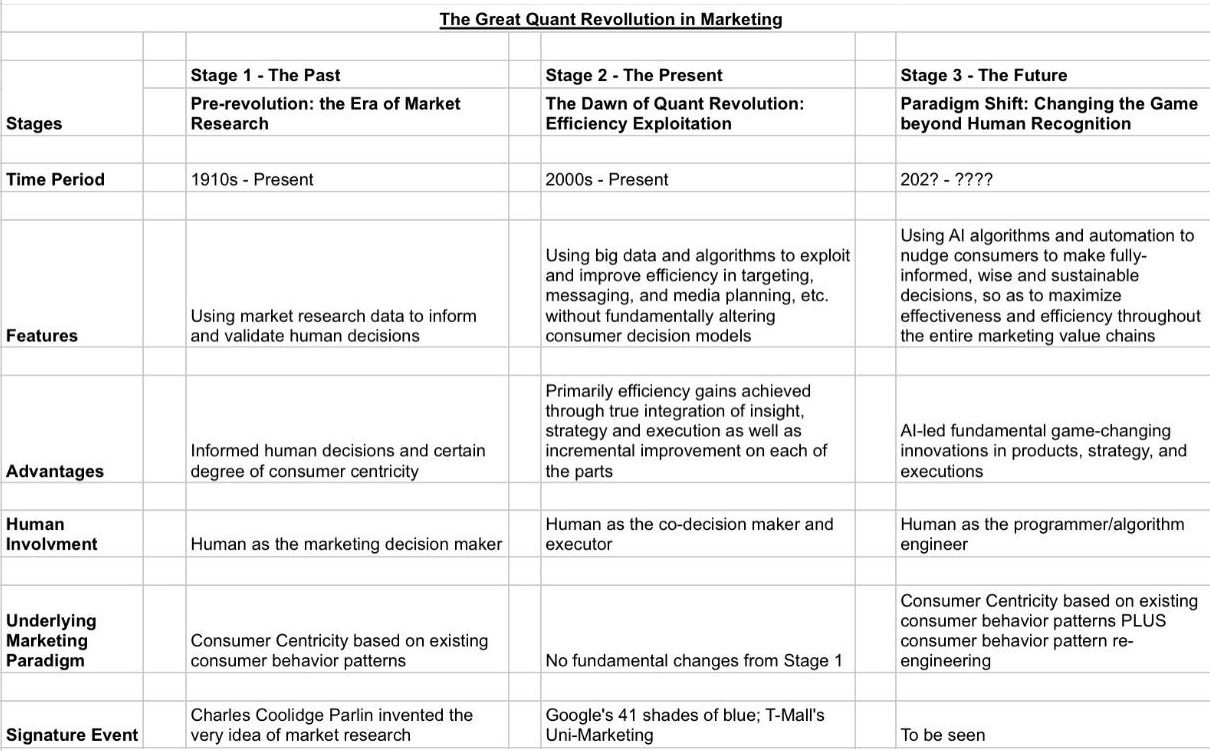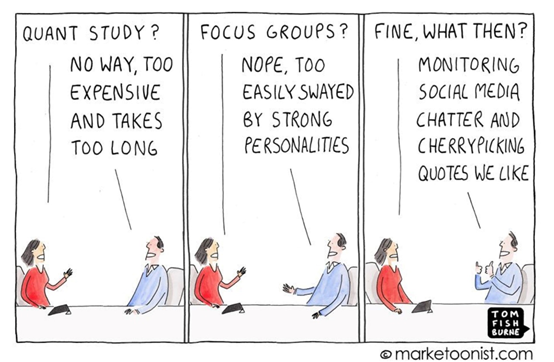In case you haven’t noticed, for
us marketers, there is a revolution going on.
What revolution?! Some may ask.
Well, it is the same great quant revolution that, like a perfect storm, has
forever changed many other industries - professional sports, investment, and
etc.
In the investment business, data
has always been very important. Especially for value investors, it is critical
to access as much data as possible for an investment target and then try to
determine whether it is over- or under-valued or just-about-right. Value
investing as a strategy involves a fundamental judgement: is a stock
trading at significant discount against its intrinsic value?
The quant investing revolution
started in the late 1970s and early 1980s, but major breakthroughs were not
seen until the1990s. In contrast to value investing, for the most part quant
investment do not bother with fundamental judgement on intrinsic value, but
instead try to exploit market inefficiencies or to act on predictions on
short-term trading movement.
Perhaps not surprisingly,
marketing has been following a rather similar trajectory, yet some twenty years
behind quant investing. How has the quant revolution altered our industry? What
are the advantages and limitations this revolution has brought? Where is the
revolution leading to?
To answer the above questions, it
is necessary to divide the quantitative revolution in marketing into three
stages, each corresponding to the past, the present and the future (see Table).

Stage 1: Pre-Revolution
The Era
of Market Research
The invention of market research
in the 1910s for the first time allowed companies to make informed marketing
decisions, it also infused to a limited degree consumer centricity.
Instead of selling what one produces, sell what consumers want. This
simple common sense was a major breakthrough in thinking in the age of “any
customers can have a Ford any color he wants, as long as it’s black”.
While informed-decisions tend to
be better than otherwise, the role of data in this stage was to serve as either
the knowledge base or validation for human decisions. Human intelligence, with
all of its glories, also comes with many flaws. Often, market research data was
cherry-picked or entirely brush aside when it contradicts with decision maker’s
thinking, or reduced to rubber stamp to “validate” whatever decisions desired.
Furthermore, two major limitations
in market research data cast long shadows on how much impact data can exert:
data scope and granularity. Most survey nowadays lasts some 20 minutes and on
hundreds of samples. The limited amount of data that can be collected
means rather narrow and shallow data input; and the fact that findings from
small samples cannot be reliably extrapolated out to the broader population
(partly because of lack of big data) confine any conclusions to PPT slides
while attempts to execute them tend to be “lost in translation”.
Hence there has never been a
shortage of jokes on market research.

Stage 2: The Dawn of Quant Revolution
Efficiency Exploitation
Clearly, given the limitations of
market research data, it takes a new type of data in order to summon the dawn
of a new era. Yes, it had to be big data.
And in China, likely any marketing
historians, if any, would agree that Alibaba’s launch of the Uni-Marketing
framework in 2018 marked the beginning of this stage. With DataBank and
StrategyCenter, marketers for the first time got their hands on a wide array of
data on real consumer e-commerce behavior. Suddenly, insight extractions
such as consumer profiling and segmentation can be done with a wide range of
real behavioral data which yield fresh insight; and better yet, the resulted
profiling or segmentation can now become more than just a theory on a PPT
slide: target audiences can be tagged with unprecedented accuracy in the real
world (albeit in a database); and perhaps the best yet, with the insight and
accurate tagging, precise messaging and media plans can be tested in the real
world against all kinds of KPI including purchase conversion to identify the
more effective combinations. In no time, suddenly marketers were thrilled by
the magic power of increasing ROI by many folds, waste and fraud reduced, GMV
happened, …
For the first time in history,
marketers are able to extract insight with huge amount of data both in width
and depth, and directly translate strategy into testable and optimizable
executions with less “loss in translation”. And also for the first time
marketers are able to link specific strategy and campaigns to short-term GMV
and therefore ROI becomes a plausible and measurable KPI.
While big data allowed for
unprecedentedly powerful solutions, the limitations in the big data and data
platforms currently available again got into the way.
First of all, most of the big data
available is behavioral data. While the data provides more granularity and
allowed for tagging on real consumers, it has one major drawback: behavioral
data can only tell how consumers behave, not how they make decisions - in other
words, we know “what” but not “why”. As a result, identifying target groups
with higher ROI based on correlations or A/B testing is the norm. In rare
occasions, some analysts would dig out “why” using traditional market research
and then use the insight to guide big data analysis, but that’s rather the
exception than the norm. Many probably will ask, didn’t some big data guru
state that correlation is everything? Well, if you are just predicting stock
movement in the next 72 hours, yes, correlation is sufficient. But if you are
trying to figure out what is going to be the next blockbuster product or where
the consumer taste is heading to or if there is a killer selling message to be
had, correlation is utterly insufficient.

Another major limitation has to do
with the level of access existing marketing data platforms offer. Almost invariably,
the platforms do not allow apps to be embedded which can execute the analysis
automatically based on existing algorithms; nor can the A/B testing, tagging,
media placement be carried out seamlessly without tons of human interventions.
All these means that human is still the thinker and worker who makes the
decision and pushes the buttons. Marketing automation in this sense is simply
beyond reach.
Stage 3: Paradigm Shift
Changing
the Game beyond Human Recognition
If there is ever a sci-fi writer
who, out of utter boredom, wants to write about the future of marketing, most
likely it will look like this:
● Much of the routine marketing decisions, especially the executional level ones such as media spot plans, target selections, incremental improvement in communications, etc., will be carried out and optimized automatically based on self-improving algorithms; some of these are already a reality today.
● Most advertising, social media contents and so on will be largely generated by AI engines. Already, AI can compose a piece of Bach-like music to pass as a real one to even the trained ears. Similarly, machine learning can be deployed to roam through existing creative contents and the resulting black-box algorithms can be used to generate new contents with little human intervention. There are already some companies striving down this road. It is just a matter of time when some of them can churn out AI contents that can pass as the fruits of a decent copywriter.
● Similarly, machine learning will comb through consumer journey data to devise individualized consumer journey intervention plan to pinpoint the best timing or occasions to reach out to certain consumers with the most effective messages/activities in order to serve the marketing objectives, be it seeding, brand building, purchase conversion, retention, or fission.
● Aside from routine deployment of AI and algorithms, Stage 3 will demonstrate a major departure compared with Stage 2: Stage 2, for the most part, is about incremental efficiency gain working within the existing consumer behavioral and decision patterns, Stage 3 will proactively reshape these patterns by re-engineering consumer journey and restructuring consumer decision-making. Here machine learning coupled with historical data alone won’t be sufficient. Experimental design guided by behavioral sciences will shed light into the new frontiers in marketing and reveal new insight and solutions to nudge consumer decisions.
To fully realize the potential
that Stage 3 has to offer, it requires data that can depict the entire consumer
journey as complete as possible. Today’s data silos (e.g. TMall’s databank,
etc.) are very powerful but each of them alone can only cover a small corner of
the vast digital universe. Given the transforming value a full data set
possesses, it is just a matter of time before someone figures out a viable
offering.
With such a magic dataset
available, the profile of marketing professionals will increasingly look like
that of a quant fund: less will business students but more will be
mathematicians, programmers and behavior scientists.
Marketing in this stage will be full of excitement, wonders, and magic powers. In a sense, marketing, armed with data and algorithms, will be more powerful than ever in shaping consumer behaviors. But will consumers and governments tolerate that? Will consumers turn against marketing for pushing unwanted products to them like they have been with Facebook and etc? Will the governments become weary to the industry for manipulating the mass like the they have been with Cambridge Analytica and its incarnations?
Clearly marketers at the forefront
of the quant revolution need to adhere to two principles: 1. Utmost respect for
consumer privacy; and 2. Nudging consumer behavior only when it adds value to
the consumers - enabling them to make fully-informed, wise, and sustainable
consumption decisions. After all, if one day a marketer wakes up and
realizes that she possesses this magic power to shape consumer decisions, she
better asks herself this question: do I want to live in a world where marketers
freely deploy data and algorithms and manipulate my decisions with little
consideration for my own personal wellbeing?
With the stage set for the great
quant revolution, what are the implications for today’s marketers? All great
shifts in an industry inevitably bring unprecedented opportunities. At
Illuminera, we believe that these opportunities will be made available in this
revolution:
● Data Asset: data is the new oil. Any unique data sets that can complement or, better yet, replace existing data silos will be of great value.
● Algorithms and Applications: algorithms, simple or complex, that can make decisions on behalf of marketers will be embedded in automation apps. In the very near future, these apps will be making daily targeting and messaging decisions. Given more time, they would make strategic marketing decisions better than their human counterparts.
● Inter-system Automation Systems: integration systems that can link and facilitate the collaboration among various data silos, algorithms, digital media outlets, e-commerce platforms, digitalized offline touch points, and other stakeholders.
● Behavioral Sciences and Social/Cultural Forces: unlike quant investing, arbitraging market inefficiency will not make brand owners a lot of money. As such, pure statistical approach is not sufficient. We need profound insight on how consumers make decisions in order to learn how to nudge their decisions. Behavioral sciences, especially behavioral economics, coupled with social and cultural forces that sway how consumers think, will serve as the beacon when data scientists race to build the killer algorithms and apps that can nudge better than others.
Certainly the jury is still out on
whether or how the third stage will turn out. However, at this moment, I would
kill to hear well-thought out answers on what the Stage 4 might look
like.
For more information, please email us at marketing@illuminera.com